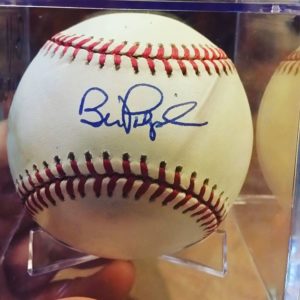The Mick Continues To Dominate The Card World!!!
Collecting baseball cards has been a cherished hobby for enthusiasts around the world, transcending generations and capturing the essence of America’s favorite pastime. The allure of these small, cardboard treasures lies not only in their nostalgic value but also in the potential for discovering rare and valuable pieces of sports history. In this essay, we will explore the art of collecting baseball cards and delve into some notable sales that have left an indelible mark on the hobby.
The tradition of collecting baseball cards dates back to the late 19th century, coinciding with the rise of professional baseball in the United States. Initially distributed as promotional tools by tobacco and confectionery companies, these cards featured images of baseball players and quickly gained popularity among fans. As the years passed, the hobby evolved, with card designs becoming more sophisticated, and the market expanding to include various brands and sets.
One of the driving forces behind the fascination with baseball cards is the connection they provide to the players and moments that have defined the sport. Each card tells a story, encapsulating a specific era or highlighting the achievements of a particular player. Collectors often find joy in assembling comprehensive sets, chasing after the cards of their favorite athletes, or pursuing rare and limited-edition releases.
Notably, the baseball card market has witnessed some remarkable sales that have astonished both collectors and the general public. One such instance is the sale of the Honus Wagner T206 card, considered the holy grail of baseball cards. Honus Wagner, a legendary shortstop for the Pittsburgh Pirates, requested to have his cards removed from the American Tobacco Company’s production due to ethical concerns. Consequently, only a handful of these cards were ever released, making them exceptionally rare. In 2016, a Honus Wagner T206 card was sold for a staggering $3.12 million, setting a record for the highest price ever paid for a baseball card.
Another noteworthy sale involved the iconic 1952 Topps Mickey Mantle card. Mickey Mantle, a baseball icon and New York Yankees legend, holds a special place in the hearts of collectors. The 1952 Topps card featuring Mantle is particularly coveted, known for its scarcity and the captivating image of the young slugger. In 2018, a pristine, gem-mint version of the card fetched a remarkable $2.88 million at auction, reaffirming the enduring appeal and investment value of vintage baseball cards.
These notable sales underscore the incredible market dynamics within the baseball card collecting community. While the hobby remains rooted in passion and nostalgia, the potential for financial gain through rare and highly sought-after cards adds an additional layer of excitement for collectors. As technology continues to shape the landscape of collecting, with online platforms facilitating trading and sales, the tradition of collecting baseball cards remains as vibrant and captivating as ever. Whether motivated by a love for the game, a desire for connection to baseball history, or the thrill of the hunt for rare gems, collectors continue to contribute to the enduring legacy of baseball card collecting. If you love autograph collecting, follow along on my journey!!! Curbside_Graph3rz on IG.
